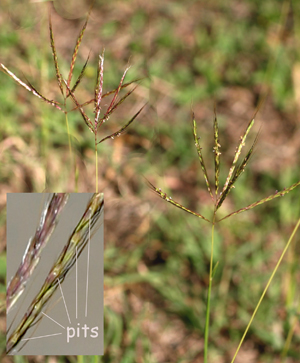|
|
|
[GENUS BOTHRIOCHLOA
|
|
|
|
|
110a
|
( 103) 103) |
First glume with a distinct pit (<1 mm across), visible to naked eye (if you have good eyesight; see Fig. 19B below) .. .
|
|
[111] |
|
110b
|
|
Glumes of spikelets lacking pits .. .
|
|
[113] |
|
~~~~ ~~~~~~~~~~~~~~~~~~~~~~~~~
|
|
|
111a
|
(110) |
Racemes subdigitate or arranged on the culm (axis) over a distance less than the length of a raceme .. .
|
|
[112] |
|
111b
|
|
Racemes arranged on the culm (axis) over a distance greater than the length of a raceme. Pedicels especially with many long hairs. Sessile spikelets 3 - 4.5 mm long { medium-size bunching grass, typically in disturbed sites and grassed verges. (See also couplet [116a]) [HAW - NAT] [?GUM - NAT] [FACU] Bothriochloa bladhii (Retz.) S. T. Blake
|
|
|
|
~~~~ ~~~~~~~~~~~~~~~~~~~~~~~~~
|
|
|
112a
|
(111) |
 Pedicellate spikelets generally similar to sessile spikelets or very slightly reduced; pedicellate spikelets with or without a pit. Sessile spikelets 3–4 mm long. Racemes usually weakly erect to strongly divergent from axis { Extremely common small grass in lawns, road verges, and open dry to mesic lands. Pitted beardgrass [HAW - NAT] [?GUM - NAT]
Pedicellate spikelets generally similar to sessile spikelets or very slightly reduced; pedicellate spikelets with or without a pit. Sessile spikelets 3–4 mm long. Racemes usually weakly erect to strongly divergent from axis { Extremely common small grass in lawns, road verges, and open dry to mesic lands. Pitted beardgrass [HAW - NAT] [?GUM - NAT]Bothriochloa pertusa (L.) A. Camus
Figure 19A. Bothriochloa pertusa inflorescences with fan-shaped arrangement of racemes arising close together and (inset) glumes with a small pit (clearly visible with a small hand lens; see Fig. 19B below).
|
|
|
112b
|
|
Pedicellate spikelets narrower than sessile spikelets, with or without a pit. Sessile spikelets 5–7 mm long. Ligule a membrane with sparse, minute cilia at apex. [HAW - NAT] { Racemes usually held stiffly erect; resembles B. pertusa. [HAW - NAT] Bothriochloa macra (Steud.) S. T. Blake
|
|
|
~~~~ ~~~~~~~~~~~~~~~~~~~~~~~~~
|
|
|
113a
|
(110) |
Pedicellate spikelets narrower than sessile spikelets .. .
|
|
[114] |
|
113b
|
|
Pedicellate spikelets similar in width to sessile spikelets .. .
|
|
[106] |
|
~~~~ ~~~~~~~~~~~~~~~~~~~~~~~~~
|
|
|
114a
|
(113) |
Pubescence of inflorescence of long hairs that obscure spikelets, whitish in color at maturity.. .
|
|
[115] |
|
114b
|
|
Pubescence of inflorescence of hairs under 2 mm long, not obscuring spikelets. Inflorescence reddish or whitish in color .. .
|
|
[116] |
|
~~~~ ~~~~~~~~~~~~~~~~~~~~~~~~~
|
|
|
115a
|
(114) |
Culm node with long hairs (villous), node may be dark purple in color. Sessile spikelet ovate, 4.5-7.3 mm long; pedicelled spikelet linear or lanceolate, 2-5 mm long. Ligule membranous without cilia (eciliate). { Uncommon, medium-sized, tufted perennial. Fuzzy top [HAW - NAT] [UPL]Bothriochloa barbinodis (Lag.) Herter
|
|
|
115b
|
|
Culm nodes glabrous. Sessile spikelet ovate, 2.5-4.5 mm long; . {?Rare, medium-sized, tufted perennial. Fuzzy top [HAW - ?NAT] Bothriochloa laguroides (DC.) Herter
|
|
|
~~~~ ~~~~~~~~~~~~~~~~~~~~~~~~~
|
|
|
116a
|
(114
&
 111) 111) |
Racemes attached along central axis from nodes spaced apart greater than length of a raceme. Pedicels especially with many long hairs. Sessile spikelets 3 - 4.5 mm long { common, medium-size bunching grass, in disturbed sites and grassed verges. (See also couplet [111b]) [HAW - NAT] [FACU]Bothriochloa bladhii (Retz.) S. T. Blake
|
|
|
|
116b
|
|
Racemes attached along central axis over a distance less than length of a raceme .. .
| |
[117] |
|
~~~~ ~~~~~~~~~~~~~~~~~~~~~~~~~
|
|
|
117a
|
(116) |
Racemes 3 - 6 in number. Sessile spikelets 4.5–7 mm long. Ligule a membrane with sparse, minute cilia at apex. { Racemes usually held stiffly erect; resembles B. pertusa [HAW - NAT]Bothriochloa macra (Steud.) S. T. Blake
|
|
|
117b
|
|
Racemes 5 - 15 in number. Sessile spikelets 3.5–5 mm long, pedicelled spikelet similar in length. Bothriochloa ischaemum (L.) Keng
|
|